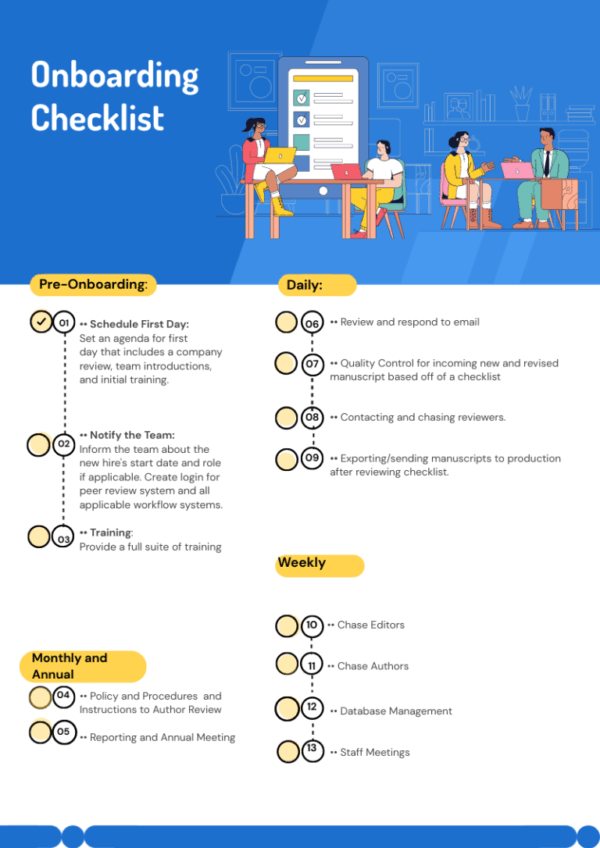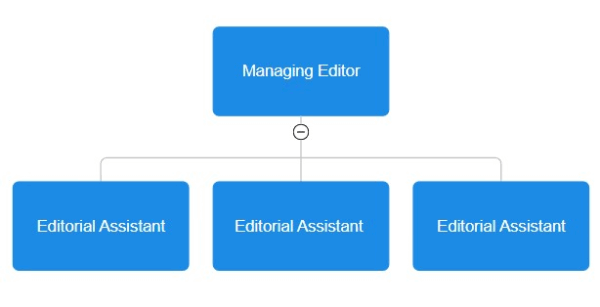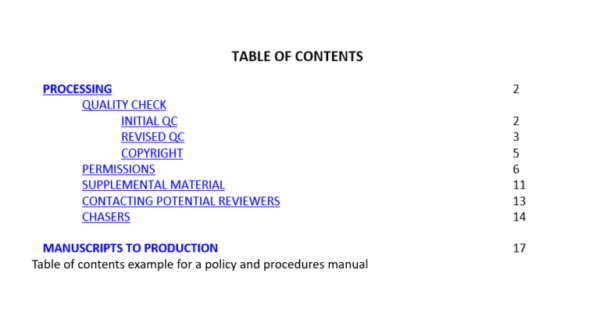Blog post
Training in the Editorial Office: Editorial Assistant
26 Nov 2024

First posted on the ORIGINal Thoughts Blog

Consultant, Origin Editorial
Owner, Editorial Evolution
X: @JenniferLMahar
LinkedIn: http://linkedin.com/in/jennifer-mahar
Take Home Points:
- Define the editorial assistant role for your journal
- Provide detailed documentation for the role
- Provide full training and continuous feedback for success
Editorial assistants are the glue that holds any editorial office together. They are the members of the team who keep things moving, pay close attention to all of the moving parts from checklists, perform initial quality control, chase editors and reviewers, and send manuscripts to production, among other tasks. They communicate important information to the various stakeholders in the peer review process through these actions. That’s a pretty big role!
Before you can train someone to be an editorial assistant, you first need to define the roles and responsibilities of the position. You should have a clear checklist of items the new team member will accomplish on a daily, weekly, monthly, and yearly basis. The below onboarding checklist contains sample tasks an editorial assistant might complete for a journal; the specific tasks associated with an editorial assistant position at your journal should be tailored to your journal’s needs.
Sample Onboarding Checklist with timeline milestones
- Quality control (QC) checks by the editorial office when a manuscript is submitted, revised, and accepted as designated by the journal. What your journal requires per your instructions to authors for a manuscript to be peer-reviewed.
- Compliance of formatting, if applicable, and specific sections of manuscript (i.e., conflicts of interest, funding, data sharing, etc.)
- Compliances for specific scientific field (i.e., Institutional Review Board (IRB)) or Consolidated Standards for Reporting Trials (CONSORT)
- Ethics screening
- Chasing of editors, reviewers, and authors
- Exporting manuscripts to production
- Email/communication
Provide a checklist in advance to your new member to alleviate guesswork. Anything not previously defined should be discussed as it arises. Be clear that the team member should come to you without hesitation with questions and concerns. Sometimes editors ask team members to handle tasks outside of their routine responsibilities, so having a policy for ad hoc queries is helpful and transparent for all stakeholders. Make sure there’s a chain-of-assistance policy for the individual, and they know who to approach to answer any questions they might have in the process. For example, if they need clarification for a decision letter, they should know whom to ask. The policy should indicate who can answer questions or address concerns throughout the editorial process so they do not have to make difficult decisions on their own. This support would generally be in the form of a managing editor. For example, if a reviewer raises an ethical concern during the peer-review process, it can be flagged for the managing editor to address. Provide an organizational chart for your editorial assistant for all aspects of the journal; knowing who to go to for anything that comes up allows for quick resolution, clear expectations, and total support. Your editorial assistant should know to whom the ethics concerns are sent. They should know where to forward permissions and copyright questions. They should know who the owner of the style guide is and be able to communicate questions easily. This will depend upon your organization—if you work in a society office your org chart will look very different than if you work at a publisher.
Sample Organizational Chart for an editorial office with one managing editor and three editorial assistants.
When training an editorial assistant, you often need to train recent college graduates and entry-level peer review personnel. This is an excellent entry into the world of publishing to learn about peer review. Your trainee will need to have a full understanding of the peer review process, including turnaround times, the stakeholders involved, and related policies and procedures.
Provide your new team member with your full policy and procedures (P&P) manual. If you don’t have one, now is your opportunity to get organized. Every step of your training should be well defined in your P&P.
The broad stroke components of peer review should be communicated to your editorial assistant. They should have a good understanding of the reasons and rational of their work. We are training the future so the importance of your training should not be undervalued.
Other considerations for training your editorial assistant include:
Defining Peer Review: Peer Review, as defined by the Merriman-Webster dictionary, is “a process by which something proposed (as for research or publication) is evaluated by a group of experts in the appropriate field. You should strive to define peer review for your discipline and specific journal; all journals are different and those differences are what makes each journal unique; sharing that information with your new hire is important.
Explaining the Process of Peer Review: Break down the entire process of bringing a manuscript through peer review for your journal—including the research part. Research looks very different in many fields. The more we can understand about the origins and writing of a paper, the more we can appreciate and effect how it comes into our offices.
Reviewing Instructions to Authors: Your very first homework assignment for your trainee should be to have them review your instructions to authors and provide you with feedback. Would you be able to step into a journal to manage if you read your instructions to authors? Are there items not transparent to your readership that someone training would not be able to glean from your instructions? You should be listing as much as possible here for transparency and clarity for all—authors, reviewers, editors, and readers.
Training on Your Peer Review System: Your journal uses a peer review system to process manuscripts. Many new editorial assistants may not know how to use these systems. You will need to undertake a full review of how your journal uses the system and train them on the entire process. Some peer review systems have online training modules, YouTube videos, and online literature that you can provide to your new staff member to augment your own training. Each journal has its’ own subtle ways they use their system and reviewing those differences is an important part of your training. Below are some YouTube options you can review and/or share with your staff when constructing your training. You can also create your own video training modules for your staff to refer to for common questions.
ScholarOne information
Editorial Manager information
- https://service.elsevier.com/app/answers/detail/a_id/29499/supporthub/publishing/p/13783/
- https://www.ariessys.com/support-and-resources/resources/
There are many newer peer review systems in this space. Most are built upon the basic premise that you have two databases, one full of people and one full of manuscripts. No matter the system, training should be provided, and continued support should be available.
System-agnostic training of peer review, understanding your editorial office, and meeting your newest team member where they are is paramount.
Your training should be structured and ready to go at a moment’s notice. Life changes fast and if you need a new team member you must be ready to hit the ground running.
Have a mentor available for at least the first month—more if possible. This is an invaluable asset to a new hire and gives them the tools they need to be successful.
Have Fun: Take the opportunity to check in with your new hire; in the beginning you’ll need to be available via agreed-upon means (for example, Teams, Skype, text, etc.); but as time moves on you can schedule weekly, bi-monthly, or even monthly meetings. But always take the time to check in, even if it’s only a five-minute meeting showing each other’s pets sleeping; it’s important to humanize our work experiences. Your team is only as good as its newest team member, so be sure to take on training in a methodic, thorough way and never stop, everyone can use continuous editorial training!
Suggest to your editorial assistant that they engage in ongoing education through professional editorial organizations. The Council of Science Editors (CSE) and the International Society for Medical and Technical Editors (ISMTE) are two excellent resources for your Editorial Assistant. Consider funding membership for your team member for these empowering organizations.
Your own private island
I recognize that an editorial office can sometimes be a lonely island with one sole staff member who serves all parts of the editorial office, soup to nuts. This could be a contractual arrangement with a publisher or society or the journal only has enough submissions to support one person. It’s also becoming increasingly common for an editorial assistant to handle only a portion of the submission process—for example they intake papers but do not process acceptance letters or handle any peer review communications like contacting authors or chasing reviewers. In these instances, there should still be guidance for these positions, it’s important for members to feel a part of something, have clear instruction, and feel valued. If you are an editorial assistant in this boat, please know there are resources available in our community at CSE and ISMTE that can help you on your editorial journey.
Successful Training
The most gratifying experience for me is when I see someone that I trained become successful; sometimes I catch a LinkedIn post that they have moved onto another position, sometimes it’s in the form of thanks and accolades from the workplace. Successful training is when someone reaches a point that they are self-confident in the work they are doing, they work autonomously but part of the team (where applicable), and they enjoy their work. The highest form of success is when your trainee can suggest new, innovative, and alternate ways to accomplish tasks. Successful training also means the trainee may soon outgrow the role and move on, allowing you to restart the process and train the next editorial assistant.
Training in the editorial office is important and the editorial assistant is a vital member of your team. With thorough and continual training, your team member will grow and prosper in our community and keep our industry alive!
Origin Editorial is now part of KnowledgeWorks Global Ltd., the industry leader in editorial, production, online hosting, and transformative services for every stage of the content lifecycle. We are your source for society services, market analysis, intelligent automation, digital delivery, and more. Email us at info@kwglobal.com.
Related Posts

Building Resilient Publishing Programs: a Conversation with Three Society Publishers

Connection is the Heart of Association Membership





